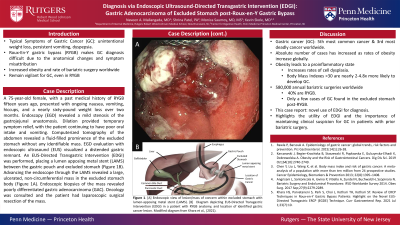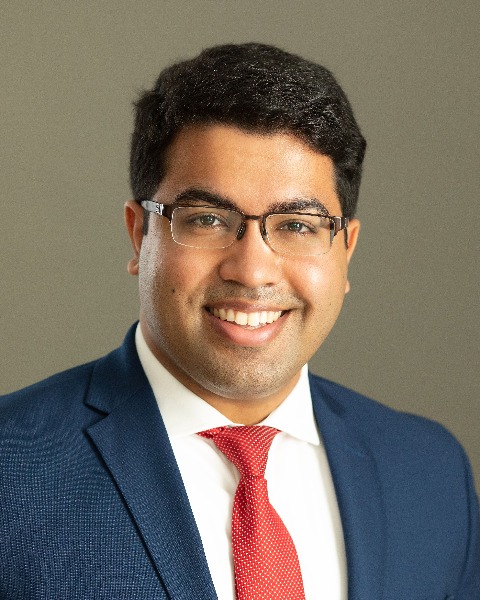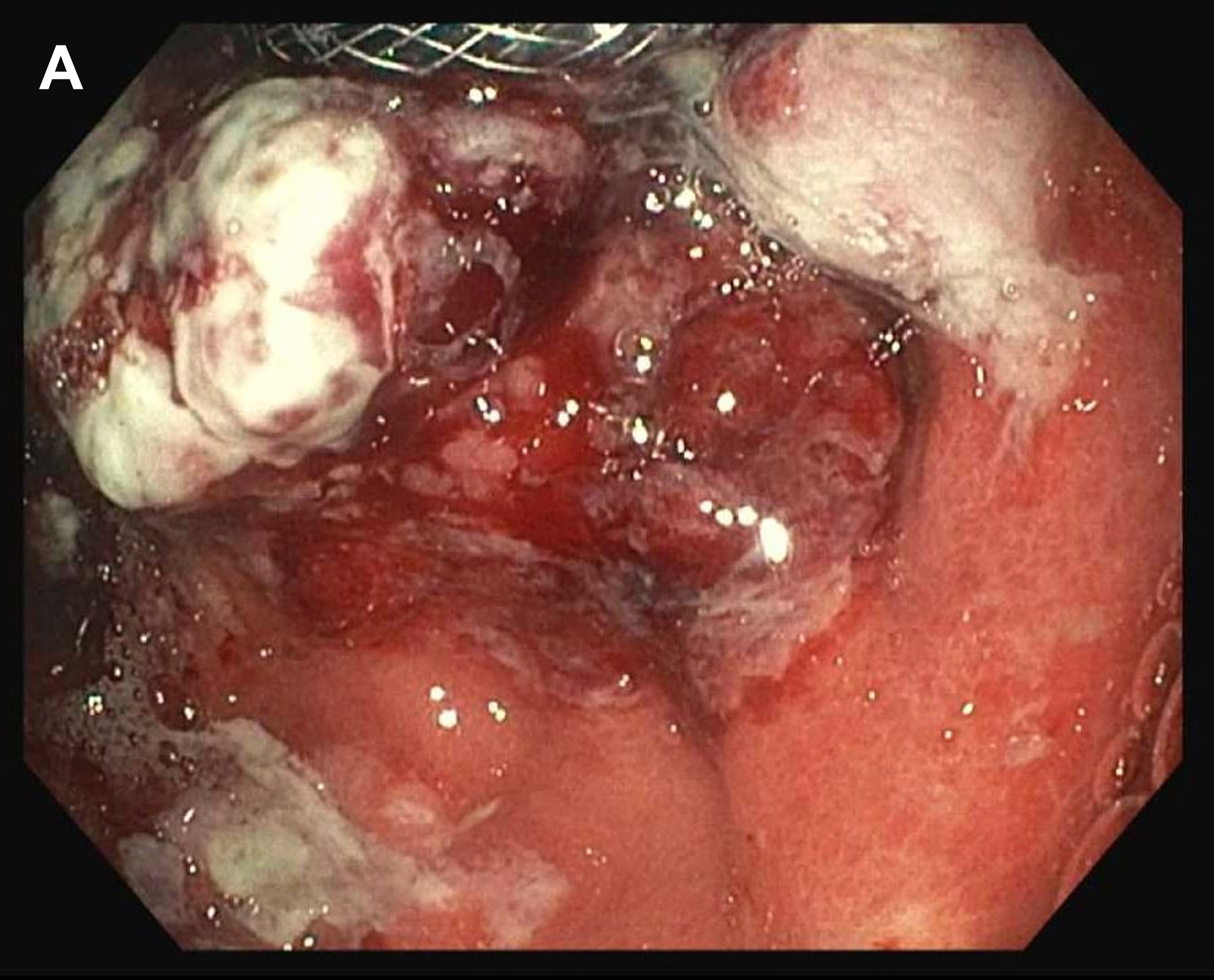Sunday Poster Session
Category: Stomach
P1350 - Diagnosis via Endoscopic Ultrasound-Directed Transgastric Intervention: Gastric Adenocarcinoma in the Excluded Stomach After Roux-en-Y Gastric Bypass
Sunday, October 22, 2023
3:30 PM - 7:00 PM PT
Location: Exhibit Hall

Has Audio

Naveen Mallangada, MD
Rutgers Robert Wood Johnson Medical School
New Brunswick, NJ
Presenting Author(s)
Naveen Mallangada, MD1, Shrina Patel, PA-C2, Monica Saumoy, MD, MS2, Kevin Skole, MD3
1Rutgers Robert Wood Johnson Medical School, New Brunswick, NJ; 2Penn Medicine-Princeton Physicians, Center for Digestive Health, Plainsboro, NJ; 3Rutgers Robert Wood Johnson Medical School/Penn Medicine-Princeton Physicians, Center for Digestive Health, Plainsboro, NJ
Introduction: Gastric cancer (GC) manifests with symptoms such as unintentional weight loss, persistent vomiting, and dyspepsia. Diagnosis of gastric cancer is challenging in patients with Roux-en-Y Gastric Bypass (RYGB) due to the anatomical changes and misattribution of symptoms secondary to the weight-loss procedure. As the prevalence of obesity and rate of bariatric surgery rise worldwide, we should maintain clinical suspicion for GC in patients with prior bariatric surgery.
Case Description/Methods: A 75-year-old female, with a past medical history of RYGB 15 years ago, presented with ongoing nausea, vomiting, hiccups, and a nearly sixty-pound weight loss over two months. Endoscopy (EGD) revealed a mild stenosis of the gastrojejunal anastomosis. Dilation provided temporary symptom relief, with the patient continuing to have poor oral intake and vomiting. Computerized tomography of the abdomen revealed a fluid-filled prominence of the excluded stomach without any identifiable mass. EGD evaluation with endoscopic ultrasound (EUS) visualized a distended gastric remnant. An EUS-Directed Transgastric Intervention (EDGI) was performed, placing a lumen apposing metal stent (LAMS) between the gastric pouch and excluded stomach. Advancing the endoscope through the LAMS revealed a large, ulcerated, non-circumferential mass in the excluded stomach body (Image A). Endoscopic biopsies of the mass revealed poorly differentiated gastric adenocarcinoma. Oncology was consulted and the patient had laparoscopic surgical resection of the mass.
Discussion: Gastric cancer (GC) is the fifth most common cancer and third most deadly cancer worldwide. Although the incidence of GC has declined in recent decades, the absolute number of cases has increased as rates of obesity increase globally.
Obesity leads to a proinflammatory state that increases rates of cell dysplasia. Body Mass Indexes greater than 30 are nearly 2-4.8 times more likely to develop GC. Of the nearly 580,000 annual bariatric surgeries worldwide, 40% are RYGB. Despite this, there are only a few cases of GC found in the excluded stomach post-RYGB. Diagnosis involves endoscopic or laparoscopic intervention, with our case exclusively utilizing EDGI for diagnosis.
In conclusion, this is a case of a gastric adenocarcinoma in the excluded stomach of a patient after a distant RYGB procedure, diagnosed via EDGI. This highlights the utility of EDGI and the importance of maintaining clinical suspicion for GC in patients with prior bariatric surgery.

Disclosures:
Naveen Mallangada, MD1, Shrina Patel, PA-C2, Monica Saumoy, MD, MS2, Kevin Skole, MD3. P1350 - Diagnosis via Endoscopic Ultrasound-Directed Transgastric Intervention: Gastric Adenocarcinoma in the Excluded Stomach After Roux-en-Y Gastric Bypass, ACG 2023 Annual Scientific Meeting Abstracts. Vancouver, BC, Canada: American College of Gastroenterology.
1Rutgers Robert Wood Johnson Medical School, New Brunswick, NJ; 2Penn Medicine-Princeton Physicians, Center for Digestive Health, Plainsboro, NJ; 3Rutgers Robert Wood Johnson Medical School/Penn Medicine-Princeton Physicians, Center for Digestive Health, Plainsboro, NJ
Introduction: Gastric cancer (GC) manifests with symptoms such as unintentional weight loss, persistent vomiting, and dyspepsia. Diagnosis of gastric cancer is challenging in patients with Roux-en-Y Gastric Bypass (RYGB) due to the anatomical changes and misattribution of symptoms secondary to the weight-loss procedure. As the prevalence of obesity and rate of bariatric surgery rise worldwide, we should maintain clinical suspicion for GC in patients with prior bariatric surgery.
Case Description/Methods: A 75-year-old female, with a past medical history of RYGB 15 years ago, presented with ongoing nausea, vomiting, hiccups, and a nearly sixty-pound weight loss over two months. Endoscopy (EGD) revealed a mild stenosis of the gastrojejunal anastomosis. Dilation provided temporary symptom relief, with the patient continuing to have poor oral intake and vomiting. Computerized tomography of the abdomen revealed a fluid-filled prominence of the excluded stomach without any identifiable mass. EGD evaluation with endoscopic ultrasound (EUS) visualized a distended gastric remnant. An EUS-Directed Transgastric Intervention (EDGI) was performed, placing a lumen apposing metal stent (LAMS) between the gastric pouch and excluded stomach. Advancing the endoscope through the LAMS revealed a large, ulcerated, non-circumferential mass in the excluded stomach body (Image A). Endoscopic biopsies of the mass revealed poorly differentiated gastric adenocarcinoma. Oncology was consulted and the patient had laparoscopic surgical resection of the mass.
Discussion: Gastric cancer (GC) is the fifth most common cancer and third most deadly cancer worldwide. Although the incidence of GC has declined in recent decades, the absolute number of cases has increased as rates of obesity increase globally.
Obesity leads to a proinflammatory state that increases rates of cell dysplasia. Body Mass Indexes greater than 30 are nearly 2-4.8 times more likely to develop GC. Of the nearly 580,000 annual bariatric surgeries worldwide, 40% are RYGB. Despite this, there are only a few cases of GC found in the excluded stomach post-RYGB. Diagnosis involves endoscopic or laparoscopic intervention, with our case exclusively utilizing EDGI for diagnosis.
In conclusion, this is a case of a gastric adenocarcinoma in the excluded stomach of a patient after a distant RYGB procedure, diagnosed via EDGI. This highlights the utility of EDGI and the importance of maintaining clinical suspicion for GC in patients with prior bariatric surgery.

Figure: Endoscopic view of the gastric adenocarcinoma after endoscopic biopsy within the excluded stomach, along with a lumen-apposing metal stent (LAMS).
Disclosures:
Naveen Mallangada indicated no relevant financial relationships.
Shrina Patel indicated no relevant financial relationships.
Monica Saumoy indicated no relevant financial relationships.
Kevin Skole indicated no relevant financial relationships.
Naveen Mallangada, MD1, Shrina Patel, PA-C2, Monica Saumoy, MD, MS2, Kevin Skole, MD3. P1350 - Diagnosis via Endoscopic Ultrasound-Directed Transgastric Intervention: Gastric Adenocarcinoma in the Excluded Stomach After Roux-en-Y Gastric Bypass, ACG 2023 Annual Scientific Meeting Abstracts. Vancouver, BC, Canada: American College of Gastroenterology.
